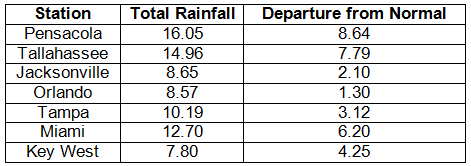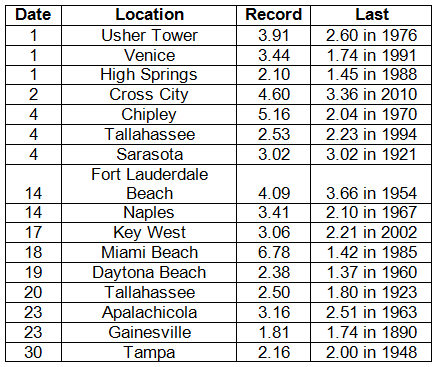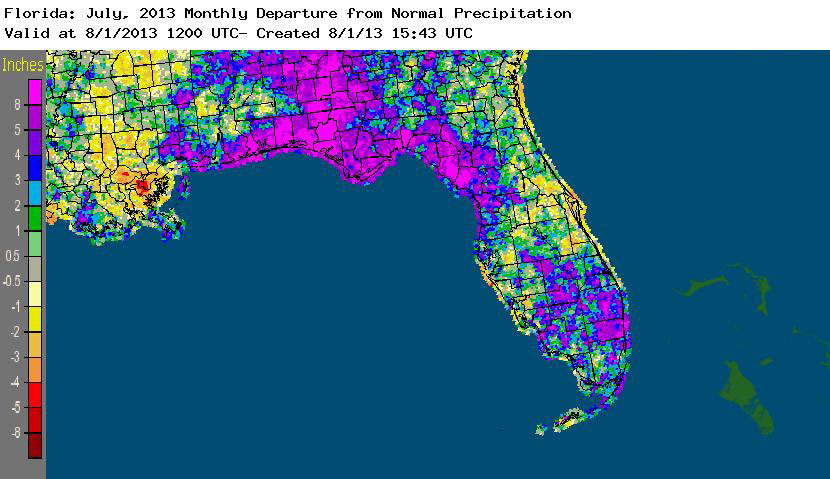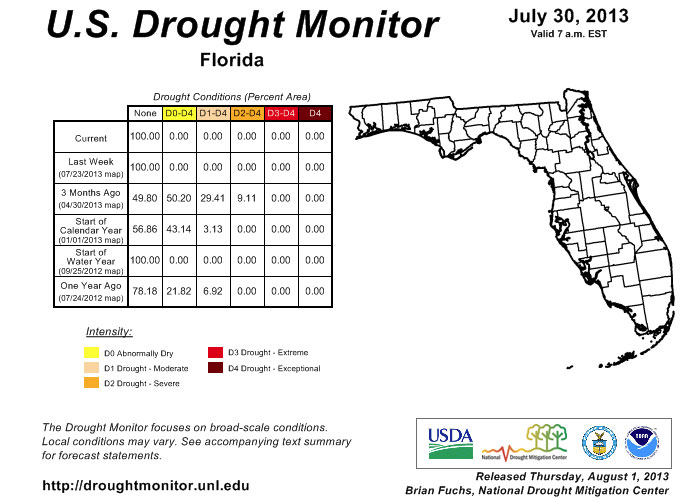| Quick Facts | |
1,296 Registered FL Observers
512 Active FL Observers
12,595 FL Reports Submitted during July
Greatest # of Daily Reports Submitted during July: 426 on 7/2/13
Most Rainfall Reported during July: 13.19" on 7/5/13 from Station FL-WT-14
|
|
|
|
New Month, New Office
|
At the beginning of August, the Florida Climate Center relocated to new offices within one of the FSU Research Foundation Buildings. This transition meant that I had to sift through and pack up 13-years worth of stuff to move to our new location. This caused only a couple of minor disruptions and I appreciate everyone's patience during the move. The new office comes with a smaller space, but two large windows, so I get to actually see the weather and not just guess at what is going on outside the building! My contact information (phone number and email) remained the same. The only change is the mailing address, so if needed, please update our new address to:
The Florida Climate Center
The Florida State University
2000 Levy Avenue, Building A
Suite 241
Tallahassee, FL 32310
|
|
Tales from the Heartland
|
As I mentioned in the last newsletter, I spent a good portion of the beginning of July enjoying some time with family and friends in Tennessee. While most of you were trying to keep your head above water from the rains (more later on that), I spent a few days in Tennessee wearing pants, especially on the 4th when the high temperature that day only reached 70˚F. I may have been born in Maryland, but after 18 years in Florida, my 'blood has thinned' and- much to the amusement of my family- that was just a bit too cool in July for me.
After the 4th of July, I boarded a plane and headed off to St. Louis, MO for the annual meeting of the American Association of State Climatologists. The meeting highlights the collaborative work done by state climatologists, regional climate centers and federal partners (NWS, NOAA) with climate data to create everything from tools that provide frost and freeze guidance to submitting a region-wide, multi-agency report on the 2012 Midwestern Drought. The weather in St. Louis was fantastic and I was able to spend a day before the meeting touring the city- and yes, I even managed to catch a Cardinals game.
 
|
|
July Rains
|
Rainfall totals across the state varied in July, though most of the state reported above normal precipitation for the month (Table 1). Portions of the Big Bend, Panhandle and southern Florida recorded up to 8 inches above normal precipitation while portions along the east coast from Jacksonville to Titusville and inland from the Orlando to the west coast between 1 to 3 inches below normal rainfall (Figure 1). The unusual rainfall pattern during the month has impacted agricultural producers with diseases, standing water and decaying crops to causing a forced release of the high water in Lake Okeechobee to keep the lake at a level that can be managed in the event of any tropical storm/hurricane impacts later in the season. July 2013 was the wettest on record in Gainesville, 3rd wettest in Pensacola, 5th wettest in Miami and 9th wettest in Tallahassee. Numerous 24-hour precipitation records were broken for the month, with one record that dated back to 1890 (Table 2).
| Table 1: July precipitation totals and departures from normal (inches) for select cities. |  |
| Table 2. Select daily rainfall records (inches) broken during July (compiled from NOAA, NWS). |  |
|
|
Figure 1. A graphical depiction of the monthly rainfall departure from normal (inches) for July is given in the figure below (courtesy of NOAA, NWS).
|  |
|
|
July CoCoRaHS Totals
|
Wow!
That's about all I can say when I looked back over the month and tried to summarize all of the rain that fell in 31 days. I pulled up a quick report from the CoCoRaHS 'View Data' Page and took a quick glance at the monthly totals for those stations that reported daily values for each day in July. The lowest total I found was 4.79" at FL-LK-3 (Groveland) and the highest was 27.76" at FL-WT-14 (Inlet Beach).
Here are the CoCoRaHS rainfall totals for July from some select CoCoRaHS stations across the state.
|
|
Current State of the Drought
|
The dry conditions that had lingered in the Panhandle at the beginning of July were completely removed after an unusual atmospheric weather pattern allowed for an extremely moist flow over the state. Rainfall totals for the month (Table 2 and Figure 1) were well above normal across Florida, wiping out all the remaining traces of drought conditions in the state. With all of the rain, interests have shifted from a drought focus, to inland flooding as many rivers in the state are near flood stage. The current wet pattern is forecasted to hold through October, which should keep any drought conditions that appear localized and not severe.
The National Drought Monitor is updated weekly, so you can always check the most recent conditions here:
http://www.drought.unl.edu/dm/DM_state.htm?FL,SE.

|
|
|
Odds and Ends
|
A few reports in Florida were flagged and required some additional information during July. I appreciate how understanding the contacted observers were, along with how quick they were to reply to my emails, though there are a few outstanding issues that need to be resolved. Please remember: if you receive an email from me with the subject line 'Question About Your Recent CoCoRaHS Observation', please take a moment to answer me back. And if you have any questions, please feel free to contact me.
Make sure to check out the monthly WxTalk Webinars offered by CoCoRaHS. Each month features a different weather-related topic and gives a chance for our observers to interact with the speaker. If you are unable to attend or have missed some of the previous month's talks, you can find them archived on the CoCoRaHS YouTube site: http://www.youtube.com/cocorahs/
Make sure to like 'Florida CoCoRaHS' on Facebook! Observers can now post comments and pictures to the wall.
| |
|
Thank You!
Thank you for your continued support and enthusiasm! If at any time you have questions about CoCoRaHS, reading your rain gauge, or finding a location to setup your rain gauge, please feel to contact a Florida CoCoRaHS Coordinator. We are lucky enough to have regional support from National Weather Service offices across the state, as well as county/local help from several CoCoRaHS volunteers.
 Melissa Griffin Florida CoCoRaHS State Coordinator Assistant State Climatologist Florida Climate Center/Center for Ocean-Atmospheric Prediction Studies Florida State University 232 R.M. Johnson Building Tallahassee, FL 32306-2840 (850) 644-0719 griffin@coaps.fsu.edu | |
|